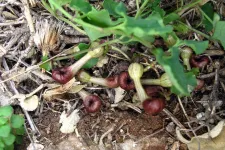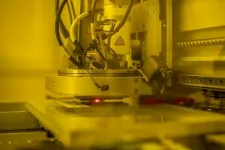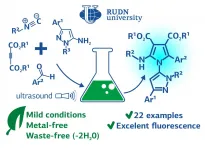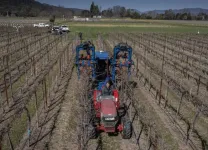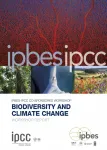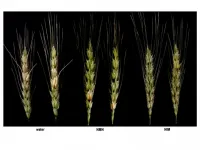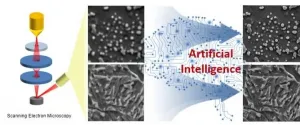Research establishes safe water thresholds for antimicrobials, to help mitigate resistance
Researchers have made progress towards a G7 commitment to establish safe standards for the release of antimicrobials into the environment, by developing a new framework that establishes safe thresholds
2021-06-10
(Press-News.org) Researchers have made progress towards a G7 commitment to establish safe standards for the release of antimicrobials into the environment, by developing a new framework that establishes safe thresholds.
The threat of bacteria developing resistance to antimicrobial drugs (often called antibiotics) used to treat infection is one of the greatest global health challenges, potentially resulting in 10 million deaths per year by 2050.
A major issue is the spread of antimicrobials and resistant bacteria through water systems. When we take antibiotics, 70 per cent passes through our bodies into wastewater. Farm animals are treated with antibiotics which can also end up in aquatic systems through run-off and flooding. University of Exeter research has previously shown that even when antimicrobials are present in these waters at low levels, they can contribute to the evolution of resistant bacteria. These bacteria can make their way into our guts, potentially causing health problems.
Last month, the G7 Climate and Environment Ministers' Meeting Communiqué recognised that the release of antimicrobials into the environment can select for antimicrobial resistance (AMR) and have an impact on human, animal and environmental health. The communique reads: "We note with concern that there are currently no international standards on safe concentrations of antimicrobials released into the environment from, inter alia, pharmaceutical manufacturing, healthcare facility effluent, agriculture and aquaculture. We also acknowledge the work of the AMR Industry Alliance in this regard. We commit to accumulate knowledge on AMR in the environment. We will work with our ministerial colleagues with responsibility for health, food, farming and medicines regulators where independent of government, as appropriate to develop and agree such standards."
Now, in a paper published in Water Research, the Exeter team worked with global pharmaceutical company AstraZeneca to make a significant step towards meeting this need. After reviewing the available evidence in the field, they have developed a framework which effectively provides guidance on how to perform a risk assessment to ensure the levels of antimicrobials released into the environment are safe. Currently there are no thresholds for safe levels of antimicrobials in wastewater and aquatic systems, although the EU and UK government are monitoring the emerging evidence.
Dr Aimee Murray, of the University of Exeter, lead author on the paper, said: "Over the past few years, our research has helped understand the urgent threat posed by the evolution of AMR in our waters and in the environment. We're delighted to see the G7 Climate and Environment Ministers' Meeting commit to taking action. Our new paper is a significant step towards informing policy that can ensure the levels of antimicrobials we release into the environment are safe."
The Exeter team's review summarises and critically appraises the current approaches that study the concentrations of antimicrobials that increase AMR. They have consolidated terminology and recommended how data (including data generated at Exeter) on selection for AMR can best be analysed to establish safe thresholds for release into the environment. By collating and assessing available data, they have recommended what these safe thresholds could be, to enable governments to act to reduce them.
Professor Will Gaze, of the University of Exeter, said: "if we don't take action now, AMR could be a greater threat to humanity than COVID-19 over the coming decades. Our work over the last decade represents a significant contribution to understanding the role of the environment in the evolution and transmission of AMR. There is still uncertainty regarding the complex processes that lead to antimicrobial resistance genes being mobilised from environmental bacteria to human pathogens and how the presence of antimicrobials in natural environments drives this phenomenon."
Professor Jason Snape, Global Head of Environment at AstraZeneca, said: "This framework is the latest output from our partnership with the University of Exeter, which has helped us over the past eight years to establish science-driven, risk-based targets for discharge concentrations for antibiotics, both to meet our commitments as a company and for our industry, addressing critical knowledge gaps in support of science-based policy to address environmental risks associated with AMR."
INFORMATION:
The paper is entitled 'Dawning of a new ERA: Environmental Risk Assessment of antibiotics and their potential to select for antimicrobial resistance', and is published in Water Research. Aimee Murray was funded by a NERC Industrial Innovation Fellowship NE/R01372X/1.
ELSE PRESS RELEASES FROM THIS DATE:
2021-06-10
Plants use numerous mechanisms for their pollination. Now botanists have discovered a particularly sophisticated system among pipevines that is based purely on deception.
The flowers of the Greek plant Aristolochia microstoma emit a foul, musty scent that seems to mimic the smell of decaying insects. The fly pollinators from the genus Megaselia likely get attracted to this odor while searching for arthropod corpses to potentially mate over and lay their eggs. Then, when entering the tube of an Aristolochia flower, the flies are guided by downward-pointing hairs into a small chamber, which holds the female and male floral organs. Trapped inside, they deposit pollen they carry onto the stigma, before the stamens ripen and ...
2021-06-10
It eventually became a Nobel prize-winning revolution when researchers first engineered CRISPR as a gene editing technology for bacterial, plant, animal and human cells. The potential of the technology is great and span from curing genetically disposed diseases to applications in agricultural and industrial biotechnology, but there are challenges.
One such challenge consists of selecting a so-called gRNA molecule which should be designed to guide the Cas9 protein to the right location in the DNA where it will make a cut in relation to the gene editing.
"Typically, there are multiple possible gRNAs and they are not all equally efficient. Therefore, ...
2021-06-10
Using a new 3D printing process, University of Nottingham researchers have discovered how to tailor-make artificial body parts and other medical devices with built-in functionality that offers better shape and durability, while cutting the risk of bacterial infection at the same time.
Study lead, Dr Yinfeng He, from the Centre for Additive Manufacturing, said: "Most mass-produced medical devices fail to completely meet the unique and complex needs of their users. Similarly, single-material 3D printing methods have design limitations that cannot produce a bespoke device with multiple biological or mechanical functions.
"But for the first time, using a computer-aided, multi-material ...
2021-06-10
RUDN and Shahid Beheshti University(SBU) chemist proposed an eco-friendly method for the synthesis of pyrrole and pyrazole derivatives with a wide range of applications in medicine: from antidepressants to anticancer. Moreover, the synthesized compounds possess interesting fluorescence features, and the bioactive scaffolds might attract great interest in the fields of clinical diagnostics and biomedical research in the future. The results are published in the Organic & Biomolecular Chemistry.
Heterocyclic compounds expose remarkable chemistry with significant applications in medicinal and organic chemistry, industry, and pharmaceutical. These compounds are widely ...
2021-06-10
Wine grape growers in California and elsewhere face increasing labor costs and severe labor shortages, making it difficult to manage and harvest a vineyard while maintaining profitability. Growers are increasingly turning to machines for pruning, canopy management and harvesting, but how well these practices are executed can substantially affect yield and quality. A new review by researchers at the University of California, Davis, published in the journal Catalyst, provides guidelines for growers to make the best use of machines.
"Wine grape laborers have been virtually nonexistent. People don't want to work in vineyards anymore because it's remote, tough work," said Kaan Kurtural, professor of viticulture and enology and extension ...
2021-06-10
BONN, 10 June - Unprecedented changes in climate and biodiversity, driven by human activities, have combined and increasingly threaten nature, human lives, livelihoods and well-being around the world. Biodiversity loss and climate change are both driven by human economic activities and mutually reinforce each other. Neither will be successfully resolved unless both are tackled together.
This is the message of a workshop report, published today by 50 of the world's leading biodiversity and climate experts.
The peer-reviewed workshop report is the product of a four-day virtual workshop between ...
2021-06-10
Kanazawa, Japan - Fungal diseases in cereal crops cause major economic losses and also threaten human and livestock health, because some fungi produce powerful toxins that might enter the food chain. Farmers use fungicides to control crop diseases, such as wheat head blight. Although agrochemicals are rigorously tested for safety, there can be concerns over chemical residues in food.
Now, researchers at Kanazawa University, in collaboration with colleagues at Ehime University and Nagoya University, have shown that the natural substance nicotinamide (NIM - a vitamin found in food and used as a dietary supplement) can help stimulate ...
2021-06-10
Curtin University researchers have helped uncover the four billion year old story of a lunar sample brought from the Moon to Earth, by the manned Apollo 17 mission more than 50 years ago.
The global research collaboration, involving scientists from the UK, Canada, Sweden and Australia, aimed to analyse the ancient rock sample through a modern lens to find out its age, which crater it came from and its geological trajectory.
That modern lens was provided, in part, by both Curtin's Geoscience Atom Probe Facility* and Space Science and Technology Centre* (SSTC) where the research team was ...
2021-06-10
With the onset of the 4th industrial revolution, artificial intelligence has recently been utilized in smartphone cameras, providing functions such as auto-focusing, face recognition, and 100x zoom, to dramatically improve our daily life. It has also been applied to research and development of new materials.
A joint research team from POSTECH and Korea Institute of Materials Science (KIMS) has applied deep learning to the scanning electron microscopy (SEM) system to develop a technique that can detect and improve the quality of SEM images without human oversight. The EMS is an essential material analysis equipment used for developing new materials. The findings from this research were recently published ...
2021-06-10
An inter-university research group has succeeded in constructing the gene expression network behind the vascular development process in plants. They achieved this by performing bioinformatics analysis using the 'VISUAL' (*1) tissue culture platform, which generates vascular stem cells (*2) from leaf cells. In this network, they also discovered a new BES/BZR transcription factor (*3), BEH3, which regulates vascular stem cells. In addition, they illuminated a novel vascular cell maintenance system whereby BEH3 competes with other transcription factors from the same BES/BZR family in order to stabilize vascular stem ...
LAST 30 PRESS RELEASES:
[Press-News.org] Research establishes safe water thresholds for antimicrobials, to help mitigate resistance
Researchers have made progress towards a G7 commitment to establish safe standards for the release of antimicrobials into the environment, by developing a new framework that establishes safe thresholds
